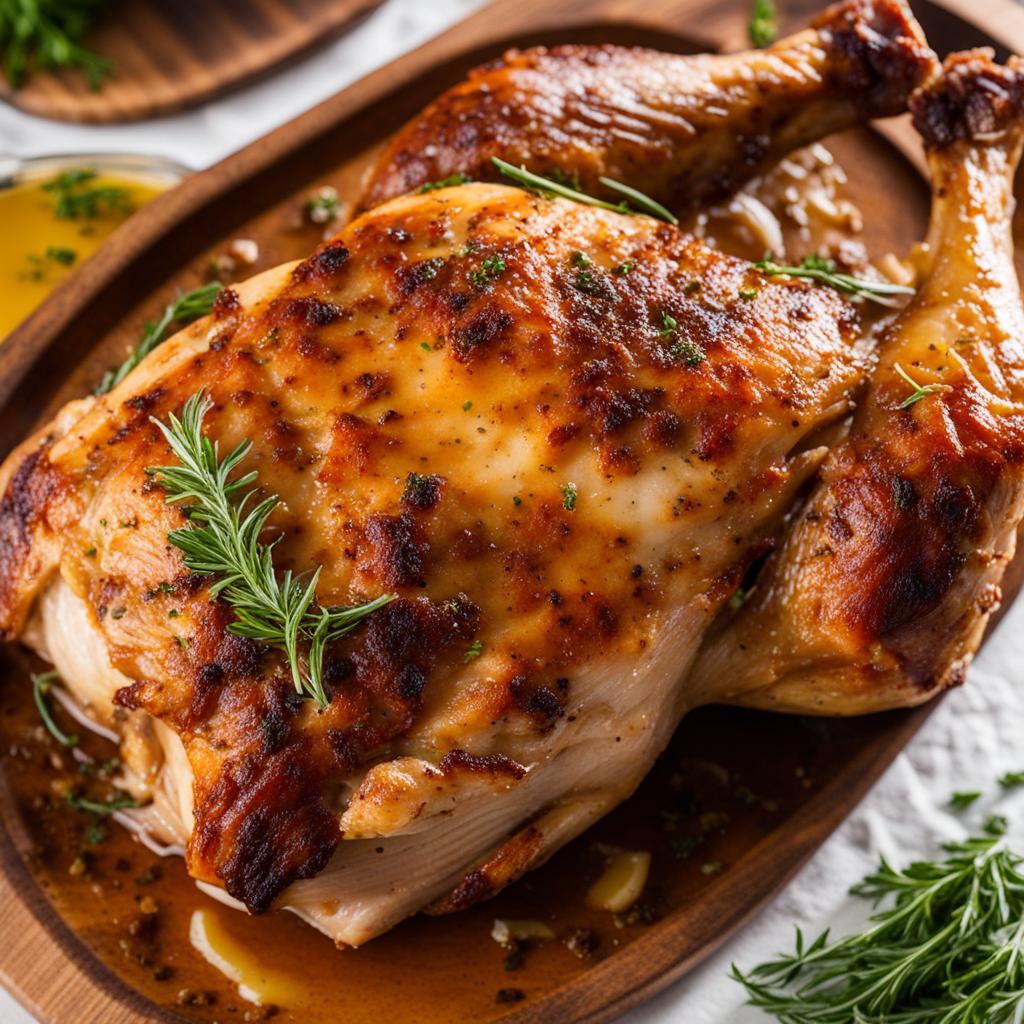Deboning a chicken thigh is a valuable culinary skill that can elevate your cooking expertise and provide you with more options in the kitchen. Whether you’re looking to create boneless thighs for a specific recipe or want to keep the skin intact, this step-by-step guide will show you how to debone a chicken thigh with ease.
Key Takeaways:
- Deboning chicken thighs saves money and offers more cooking options.
- Bone-in thighs are budget-friendly and provide bones for making stock.
- Deboning simplifies meal prep and reduces cooking times.
- A sharp knife and proper technique are essential for deboning.
- Deboned chicken thighs can be used in a variety of recipes.
Why Debone Chicken Thighs
Deboning chicken thighs offers a range of advantages in your cooking endeavors. Whether you prefer bone-in or boneless thighs, understanding the benefits of deboning can elevate your culinary experience. Let’s explore why deboning chicken thighs is worth considering.
Enhances Recipe Versatility
By deboning chicken thighs, you have the flexibility to use either bone-in or boneless thighs in your recipes. Bone-in thighs are often more budget-friendly, making them an excellent choice for cost-conscious cooks. The bones can also be reserved for making flavorful stocks and broths. On the other hand, boneless thighs with the skin intact provide the opportunity to achieve crispy skin, adding texture and extra flavor to your dishes.
Simplifies Meal Prep and Cooking Times
Deboning chicken thighs simplifies meal preparation and reduces cooking times. With boneless thighs, you eliminate the step of removing the bone while preparing the dish, saving you time and effort. This is especially beneficial when you’re short on time or need to prepare quick and easy meals for busy weeknights.
Unlocking Flavor and Texture Potential
Deboning chicken thighs allows for greater control over the flavor and texture of your dishes. Boneless thighs can be easily marinated, allowing the flavors to penetrate the meat more thoroughly. The absence of bones also makes it easier to chop or shred the meat for various recipes, enhancing the overall dining experience.
Whether you’re seeking recipe versatility, cost-effective options, or a quicker cooking process, deboning chicken thighs can revolutionize your culinary creations. Experiment with different techniques and explore the endless possibilities that come with deboning chicken thighs.
| Advantages of Deboning Chicken Thighs | Bone-in Thighs | Boneless Thighs |
|---|---|---|
| Cost-effective | √ | √ |
| Crispy Skin | √ | |
| Quicker Cooking | √ | |
| Enhanced Versatility | √ | √ |
| Flavor Control | √ | √ |
| Texture Control | √ | √ |
–}}
Benefits of Deboning Chicken Thighs
Deboning chicken thighs offers several benefits that make it worth the extra effort. Whether you prefer bone-in or boneless chicken thighs, deboning provides cost-effective options for your cooking needs. Bone-in thighs are often more affordable, allowing you to stretch your budget while still enjoying flavorful and juicy meat. On the other hand, deboning boneless thighs with the skin intact offers the opportunity for crispy skin, adding a delightful texture and flavor to your dishes.
Another advantage of deboning chicken thighs is quicker cooking times. Without the bone, the meat cooks more evenly and at a faster rate, making it a convenient option for busy weeknight meals. The absence of bones also enhances the versatility of the meat, making it easier to chop or shred for various recipes. Whether you’re preparing a stir-fry, tacos, or stews, deboned chicken thighs offer greater flexibility and ease of serving.
Benefits of Deboning Chicken Thighs:
- Cost-effective option
- Crispy skin
- Quicker cooking
- Versatile meat
- Easy serving
Deboning chicken thighs opens up a world of possibilities in the kitchen, allowing you to explore different flavors, textures, and cooking techniques. Whether you’re looking to save money, achieve crispy skin, or simply streamline your meal preparation, deboning chicken thighs is a skill that will elevate your culinary prowess and bring deliciousness to your table.
Tools Needed to Debone Chicken Thighs
When it comes to deboning chicken thighs, having the right tools is essential. Here are the tools you’ll need:
- Sharp Knife: A sharp knife is crucial for precise cutting and efficient deboning. Make sure your knife is sharpened before you begin.
- Boning Knife: A boning knife is designed specifically for removing bones from meat. Its thin, flexible blade allows for better maneuverability and control.
- Paring Knife: A paring knife can also be used for deboning chicken thighs. Its smaller size and pointed tip make it useful for intricate work.
- Chef’s Knife: If you don’t have a boning or paring knife, a chef’s knife can be a suitable alternative. Its sturdy blade can handle the task, but it may require more skill and precision.
It’s important to choose a knife that feels comfortable in your hand and allows for easy slicing and maneuvering. Remember to always exercise caution when working with sharp objects and ensure that your tools are clean and well-maintained.
Step-by-Step Guide to Debone Chicken Thighs
Deboning a chicken thigh may seem daunting at first, but with the right technique and practice, it becomes a simple and rewarding process. Follow this step-by-step guide to master the art of deboning chicken thighs:
1. Prepare the chicken thigh
Place the chicken thigh on a clean cutting board, skin-side down. Locate the bone that runs along the length of the thigh. This bone is called the femur bone, and it is the main bone to be removed.
2. Expose the bone
Using a sharp knife, carefully slice along the length of the bone, separating the surrounding meat. Angle the knife towards the bone and slice down both sides to expose it further. Scrape the knife along the bone to remove the meat cleanly, making sure not to cut through the skin.
3. Separate the bone
Point the knife perpendicular to the bone and make an incision underneath to separate it from the meat. Slice both ways to separate the middle shaft of the bone from the meat. Finally, slice around and below one end of the bone to release it completely.
4. Remove the bone
Now that the bone is fully exposed and separated from the meat, pull it up vertically. Make final cuts to remove the other end of the bone from the meat. You now have a perfectly deboned chicken thigh ready to be cooked!
Remember, practice makes perfect, so don’t worry if you don’t get it right the first time. With each deboning attempt, you’ll become more comfortable and efficient. Soon, you’ll be able to debone chicken thighs effortlessly, adding a new level of versatility to your culinary skills.
Tips for Deboning Chicken Thighs
Deboning chicken thighs can be a delicate process that requires precision and skill. Here are some helpful tips to ensure successful deboning:
1. Use Proper Knife Technique
When deboning chicken thighs, it’s important to use the right knife technique to achieve accurate cuts and minimize meat wastage. Make sure to use a sharp knife that allows for precise control. Hold the knife firmly and maintain a steady hand to avoid any unnecessary accidents.
2. Be Careful when Separating the Bone from the Meat
During the deboning process, pay close attention to separating the bone from the meat. Take your time to avoid leaving any meat behind, as this can affect the final result of your dish. Gently scrape the knife along the bone to ensure a clean separation.
3. Take your Time in Separating the Middle Shaft of the Bone
Separating the middle shaft of the bone from the meat can be a crucial step in deboning chicken thighs. This part requires patience and precision to achieve a clean bone extraction. Take your time to slice around and below one end of the bone to release it completely from the meat.
By following these tips, you can enhance your deboning skills and ensure the best results when working with chicken thighs. Practice makes perfect, so don’t be afraid to experiment and develop your own techniques along the way.
Uses for Deboned Chicken Thighs
Deboned chicken thighs offer a world of possibilities when it comes to culinary creations. Their versatility makes them suitable for a wide range of recipes, from comforting soups and stews to flavorful tacos and grilling masterpieces. Let’s explore some of the best uses for deboned chicken thighs in detail:
1. Soups and Stews
Deboned chicken thighs add a rich and savory flavor to soups and stews. Whether you’re making a classic chicken noodle soup or a hearty chicken and vegetable stew, the tender meat from deboned thighs will infuse your dishes with deliciousness. The absence of bones also makes it easier to enjoy every spoonful without the hassle of removing them.
2. Tacos
Add a twist to your taco night by using deboned chicken thighs as your protein of choice. Season them with your favorite spices, grill or pan-sear them to perfection, and then shred or chop the meat for tasty taco fillings. The result? Flavorful and succulent tacos that will delight your taste buds.
3. Grilling
Deboned chicken thighs are a fantastic option for grilling. Their higher fat content compared to chicken breasts keeps the meat moist and tender, even when exposed to high heat. Season them with marinades or dry rubs, grill them until they develop a delicious char, and enjoy the juicy and flavorful results.
4. Recipe Versatility and Flavor Customization
One of the great advantages of deboned chicken thighs is their ability to adapt to different cooking techniques and flavors. You can use them in various recipes, such as stir-fries, pasta dishes, salads, and more. Additionally, you have the freedom to customize the flavor profile by experimenting with different herbs, spices, and marinades.
With their versatility and incredible flavor potential, deboned chicken thighs are a must-have ingredient in a home cook’s repertoire. Whether you’re aiming to impress guests with a gourmet dish or simply want to elevate your everyday meals, deboned chicken thighs will undoubtedly deliver delicious results.

Saving Bones for Stock
When deboning chicken thighs, it’s important not to discard the bones! Instead, save them to create flavorful stock that can enhance your future culinary creations. Whether you’re making classic chicken stock or experimenting with a rich pork and chicken stock, the bones from deboned chicken thighs can be a valuable ingredient.
To save the bones, simply collect them in a freezer-safe container. You can freeze them individually or wait until you have enough to make a batch of stock. Freezing the bones ensures their freshness and prevents any potential bacterial contamination.
When you’re ready to make stock, simply combine the frozen bones with other stock ingredients, such as vegetables, herbs, and spices. Simmer them together for hours to extract all the delicious flavors. The resulting stock can be used as a base for soups, stews, sauces, and more.
| Types of Stock | Ingredients | Key Points |
|---|---|---|
| Chicken Stock | Chicken bones, vegetables, herbs, spices | – Classic stock for various recipes – Versatile and flavorful – Can be used as a base for sauces and gravies |
| Pork and Chicken Stock | Pork bones, chicken bones, vegetables, herbs, spices | – Rich and robust flavor – Great for Asian-inspired dishes – Adds depth to soups and stews |
By saving the bones from deboned chicken thighs, you can elevate your cooking to new heights and create delicious, homemade stocks that will enhance the flavors of your dishes. So, next time you debone chicken thighs, don’t throw away those bones—save them for a future stock-making adventure!
Recommended Chicken Thigh Recipes
If you’ve successfully deboned your chicken thighs, you’re now ready to explore the wide range of delicious recipes that showcase the benefits of this culinary skill. Whether you’re craving crispy skin, tender meat, or flavorful dishes, these recommended recipes are sure to satisfy your cravings. Let’s dive in!
1. Crispy Skin Chicken Thighs
Enjoy the perfect combination of crispy skin and juicy meat with this simple and delicious recipe. Start by seasoning your deboned chicken thighs with your favorite herbs and spices. Place them in a hot skillet, skin-side down, and cook until the skin turns golden brown and crispy. Flip the thighs and continue cooking until the meat is fully cooked and tender. Serve with your choice of sides for a mouthwatering meal.
2. Marinated Grilled Chicken Thighs
Infuse your deboned chicken thighs with incredible flavor by marinating them before grilling. Combine your desired marinade ingredients, such as garlic, lemon juice, soy sauce, and herbs, in a bowl. Place the chicken thighs in the marinade, ensuring they are fully coated. Allow them to marinate for at least 30 minutes, or overnight for maximum flavor. Grill the thighs over medium-high heat until they are charred on the outside and cooked through. Serve with a fresh salad or grilled vegetables for a tasty and healthy meal.
3. Chicken Thigh Stir-Fry
Create a quick and flavorful stir-fry using deboned chicken thighs for a satisfying meal. Start by slicing the thighs into thin strips. Heat a wok or skillet over high heat and add some oil. Stir-fry your favorite vegetables, such as bell peppers, broccoli, and carrots, until they are crisp-tender. Remove the vegetables from the pan and set aside. Add the chicken thighs to the pan and cook until they are no longer pink in the center. Return the vegetables to the pan and toss everything together with your choice of sauce, such as soy sauce or teriyaki sauce. Serve over steamed rice or noodles for a delicious and easy stir-fry.
With these mouthwatering recipes, you can make the most out of your deboned chicken thighs. Whether you prefer crispy skin, tender meat, or a burst of flavor, these recipes offer a variety of options to suit your taste. Get creative in the kitchen and enjoy the endless possibilities that deboned chicken thighs bring to your culinary adventures!
Handling and Storage Tips
When it comes to handling and storing deboned chicken thighs, it is important to prioritize food safety and freshness. Proper practices can help prevent contamination and ensure the best quality for your meals. Here are some tips to keep in mind:
Refrigeration:
- After deboning the chicken thighs, promptly refrigerate them to reduce the risk of bacterial growth and spoilage.
- Place the deboned thighs in an airtight container or wrap them tightly in plastic wrap.
- Keep them in the refrigerator at a temperature of 40°F (4°C) or below.
- Use refrigerated deboned chicken thighs within 2-3 days for optimal freshness and flavor.
Freezing:
- If you don’t plan to use the deboned thighs within a few days, freezing is a great option to extend their shelf life.
- Wrap each deboned thigh individually in plastic wrap or place them in separate freezer-safe bags.
- Label the packages with the date to help you keep track of their freshness.
- Store the deboned thighs in the freezer at 0°F (-18°C) or below.
- Frozen deboned chicken thighs can be stored for up to 6 months without significant loss of quality.
By following these handling and storage tips, you can ensure that your deboned chicken thighs remain safe to eat and maintain their freshness for longer periods. Whether you choose to refrigerate or freeze them, proper storage practices will help you enjoy delicious meals while minimizing the risk of contamination.

Table: Comparison of Refrigeration and Freezing
| Aspect | Refrigeration | Freezing |
|---|---|---|
| Temperature | 40°F (4°C) or below | 0°F (-18°C) or below |
| Shelf Life | 2-3 days | Up to 6 months |
| Convenience | Quick access for immediate use | Long-term storage |
| Freshness | Optimal freshness for a shorter duration | Good quality, with some loss of texture over time |
| Safety | Reduces the risk of bacterial growth | Preserves the quality and safety of the meat |
Table: Comparison of refrigerating and freezing deboned chicken thighs.
Cleaning and Maintenance of Tools
When it comes to deboning chicken thighs, having clean and well-maintained tools is crucial for a safe and efficient process. Proper tool cleaning and maintenance not only ensure the longevity of your knives but also contribute to the sharpness, durability, and safety of your tools.
Knife Care
To keep your knives in optimal condition, it’s important to clean them thoroughly after each use. Start by rinsing the blades under warm running water to remove any food particles. Use a mild dish soap and a soft brush or sponge to scrub the blades gently. Avoid using abrasive materials that can scratch or damage the knife’s surface.
After cleaning, dry the knives thoroughly with a clean kitchen towel or paper towels. It’s essential to remove all moisture to prevent rust and corrosion. Store the knives in a knife block or a protective sheath to keep them safe and prevent accidents.
Maintaining Sharpness
Regularly sharpening your knives is vital for maintaining their cutting performance. Use a high-quality knife sharpener or honing steel to sharpen the blades. Hold the knife at a 15-20-degree angle and glide the blade across the sharpening tool in a sweeping motion. Repeat this process on both sides of the blade several times until you achieve the desired sharpness.
Remember to hone your knives regularly as well. Honing helps realign the blade’s edge, keeping it straight and sharp. To hone a knife, hold the blade at a 20-degree angle and gently glide it along the honing steel, applying light pressure. Repeat this process on both sides of the blade.
Safety Precautions
When cleaning and maintaining your deboning tools, always prioritize safety. Use caution when handling sharp knives, and avoid leaving them unattended or within reach of children. When sharpening or honing your knives, work in a well-lit and stable area to minimize the risk of accidents.
Additionally, always follow proper knife handling techniques to prevent injuries. Hold the knife securely with a firm grip and use controlled, precise motions when deboning chicken thighs. Pay attention to your fingers and keep them away from the blade’s path to avoid accidental cuts.
| Tool Cleaning and Maintenance Tips |
|---|
| Regularly clean knives with mild dish soap and warm water |
| Dry knives thoroughly to prevent rust and corrosion |
| Store knives in a knife block or protective sheath |
| Sharpen knives regularly using a high-quality sharpener or honing steel |
| Hone knives to keep the blades aligned and sharp |
| Handle knives with caution and store them safely |
| Follow proper knife handling techniques to prevent injuries |
Advancing Your Culinary Skills
As a chef or aspiring home cook, advancing your culinary skills is essential for elevating your cooking techniques and enhancing the flavor of your recipes. Learning how to debone a chicken thigh is a valuable skill that can take your boneless meat preparation to the next level. By mastering this technique, you’ll have the ability to create a wide variety of dishes with ease and precision.
Deboning chicken thighs opens up a world of recipe possibilities. You can experiment with different flavors, stuffings, and cooking techniques to create unique and delicious meals. Whether you’re making stuffed chicken thighs, stir-fries, or grilling them to perfection, deboning allows you to customize your recipes to suit your taste preferences and culinary creativity.
Not only does deboning add versatility to your cooking repertoire, but it also enhances the presentation of your dishes. Without the presence of bones, your meals appear more refined and elegant, making them suitable for special occasions or when you want to impress your guests. The boneless meat also cooks more evenly, resulting in tender and juicy chicken thighs every time.
By honing your deboning skills, you’ll gain confidence in the kitchen and expand your culinary expertise. Practice this technique regularly to perfect your knife skills and improve your efficiency. As you continue to advance your culinary skills, you’ll discover new ways to enhance the flavors, textures, and presentation of your dishes, making every meal a memorable experience.
Table:
| Benefits of Advancing Your Culinary Skills |
|---|
| 1. Increased confidence in the kitchen |
| 2. Ability to create a wider variety of dishes |
| 3. Enhanced flavor and presentation of meals |
| 4. Improved knife skills and efficiency |
| 5. Culinary creativity and experimentation |
Conclusion
Deboning a chicken thigh is a culinary skill that every home cook should master. Not only does it enhance the flavor of your dishes, but it also provides you with the versatility to create a wide variety of meals. By removing the bone, you can customize the cooking process and easily incorporate the chicken thigh into different recipes.
The deboning process allows for more efficient meal preparation. Whether you’re making soups, stews, tacos, or grilled dishes, deboned chicken thighs are a convenient option. They cook faster, saving you time in the kitchen, and they offer easy serving and portioning.
As you develop your deboning skills, you’ll discover the endless possibilities that come with boneless chicken thighs. The flavors can be customized according to your preferences, and the tender meat can be easily prepared in various ways. With deboned chicken thighs, you can take your culinary creations to the next level and impress your family and friends with delicious and versatile dishes.
FAQ
What is the purpose of deboning a chicken thigh?
Deboning a chicken thigh provides more cooking options, allows for bone-in or boneless thighs, saves money, and simplifies meal prep and cooking times.
What are the benefits of deboning chicken thighs?
Deboning chicken thighs is cost-effective, provides crispy skin and extra flavor, reduces cooking time, enhances meat versatility, and makes it easier to chop or shred for various dishes.
What tools do I need to debone a chicken thigh?
You will need a sharp knife, such as a boning knife, paring knife, or chef’s knife, with a curved bolster for easier scraping and cutting.
Can you guide me through the step-by-step process of deboning a chicken thigh?
Certainly! Follow these steps to debone a chicken thigh: 1. Place the chicken thigh on a cutting board, skin-side down. 2. Slice along the length of the bone to reveal it. 3. Angle the knife towards the bone and slice down both sides to expose it further. Scrape the knife along the bone to remove the meat. 4. Make an incision underneath the bone and slice both ways to separate the middle shaft from the meat. Slice around and below one end of the bone to release it completely. 5. Pull the bone up vertically and make final cuts to remove the other end from the meat.
What are some tips for deboning chicken thighs?
Use proper knife technique, be careful when separating the bone to avoid leaving any meat behind, take your time when separating the middle shaft of the bone, and ensure full bone removal by trimming away any gristle or bits of bone or cartilage.
What can I use deboned chicken thighs for?
Deboned chicken thighs can be used in soups, stews, tacos, or grilled dishes, allowing for easy flavor customization and compatibility with different cooking techniques.
What should I do with the bones after deboning chicken thighs?
Save the bones to make flavorful stock. Freeze them until you have enough to make stock or combine them with other stock ingredients. Chicken bones can be used to make classic chicken stock or combined with pork bones for a rich and delicious pork and chicken stock.
Can you recommend some chicken thigh recipes that showcase deboning?
Sure! Try crispy skin chicken thighs, marinated grilled chicken thighs, or chicken thigh stir-fry for delicious dishes that highlight the benefits of deboning.
How should I handle and store deboned chicken thighs?
Refrigerate or freeze the chicken thighs promptly to prevent bacterial contamination. Use them within a few days if refrigerated or store them in the freezer for longer shelf life.
How should I clean and maintain my deboning tools?
Clean the knives thoroughly after each use and store them safely. Regularly sharpen your knives to ensure optimal cutting performance and longevity.
What are the advantages of advancing my culinary skills through deboning?
Advancing your culinary skills through deboning allows for more recipe enhancement, expands your cooking techniques, and enhances your confidence and expertise in the kitchen.
Source Links
- https://thewoksoflife.com/how-to-debone-chicken-thighs/
- https://www.simplyrecipes.com/how-to-debone-chicken-thighs-step-by-step-6829908
- https://www.seriouseats.com/how-to-debone-a-chicken-thigh-7775470
Related Recipes:
 Essential Kitchen Knives for Every Beginner
Essential Kitchen Knives for Every Beginner
 Baked Bone-In Chicken Thighs: A Step-by-Step Guide
Baked Bone-In Chicken Thighs: A Step-by-Step Guide
 How to Cut Up a Chicken Breast for Recipes
How to Cut Up a Chicken Breast for Recipes
 Broth vs Stock: Understanding the Differences
Broth vs Stock: Understanding the Differences
 The 5 best knives for carving turkey in 2023
The 5 best knives for carving turkey in 2023
 Discover the Best Knife for Carving Turkey – A Must Have!
Discover the Best Knife for Carving Turkey – A Must Have!
 How to Cut a Whole Chicken: Tips and Tricks
How to Cut a Whole Chicken: Tips and Tricks
 How Long To Roast A Chicken (Easy Step-by-Step Guide)
How Long To Roast A Chicken (Easy Step-by-Step Guide)








